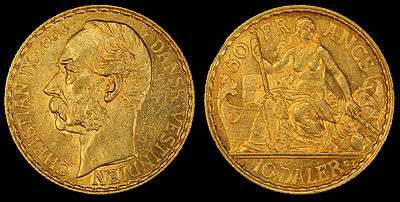Danish West Indian daler
The daler (Danish, plural the same or dalere, English: dollar) was the currency of the Danish West Indies between 1849 and 1917, and of the United States Virgin Islands between 1917 and 1934.[1]
History
| Christian IX of Denmark | |
|---|---|
 | |
| CHRISTIAN IX • 1904 • DANSK VESTINDIEN. Bare head left. | 50 FR ANCS Half draped female by Viking ship. In exergue 10 DALER |
| | |
The daler replaced the rigsdaler in 1849. No subdivisions were issued until 1859, although a variety of coins were countermarked for use on the islands. In 1859, coins denominated in cents were introduced, with 100 cents = 1 daler.
In 1904, two new denominations were introduced, the bit and franc. The four units were related as 5 bit = 1 cent, 100 bit = 20 cents = 1 franc, 100 cents = 5 francs = 1 daler.[2] Coins were issued each denominated in two units, bits and cents, francs and cents, or francs and daler. Gold coins were struck and issued in 4 and 10 daler denominations (121,000 and 2,005 minted respectively) only in 1904.[2] Banknotes were issued denominated in francs. The franc was equal to the French franc, with text on the reverse of the banknotes (see ) giving the value in Danish kroner and øre, with 1 franc = 72 øre.
The daler was replaced by the U.S. dollar 17 years after the Danish West Indies became the U.S. Virgin Islands in 1934, with 1 dollar = 1.0363 daler. This was done through identical ordinances passed by the Colonial Councils for the municipality of Saint Thomas & Saint John and the municipality of Saint Croix, with the agreement of the US Treasury after the expiration of the charter of the National Bank of the Danish West Indies. The US dollar became legal tender on 1 July 1934, while the Danish West Indian daler coins remained legal tender until 14 July 1935 (1 year after Governor Paul Martin Pearson had proclaimed that the US government would exchange US currency for the old Danish currency at the legal rate of conversion as required under the ordinances).[1]
Coins
Between 1849 and 1859, U.S., Brazilian, British, British West Indies, French, Dutch and Spanish coins were stamped with a crowned FRVII for circulation in the Danish West Indies. Denominations listed in Krause & Mishler are 1⁄2 and 1 cent, 1⁄4, 1⁄2 and 1 dollar from the U.S.A., 1⁄8 and 1⁄4 dollar from the British West Indies' anchor coinage, British farthings, 1⁄2 and 6 pence, 1 shilling, 1⁄2 and 1 crown, French 5 sous and 1⁄2 franc, Mexican 8 reales, Dutch 25 cent and Spanish 4 maravedíes, 1, 2 and 4 reales.
In 1859, coins were introduced in denominations of 1, 3, 5, 10 and 20 cents. Except for the bronze 1 cent, these coins were silver. In 1904, with the new currency system, gold coins were introduced in denominations of 4 daler (20 francs) and 10 daler (50 francs). These were followed in 1905 by denominations of 1⁄2, 1, 2, 5, 10, 20 and 40 cents. These coins also bore the denominations 2 1⁄2, 5, 10 and 50 bit, 1 and 2 francs. The 1⁄2, 1 and 2 cents were struck in bronze, the 5 cents in nickel and the other denominations in silver.
Banknotes
Danish West Indies, Saint Croix, 2 dalere (1898)
In 1849, the State Treasury introduced notes in denominations of 2, 3, 5, 10, 50 and 100 dalere. The Bank of St Thomas issued notes denominated in dollars between 1837 and 1889. It is not indicated on the notes which dollar this was.
In 1905, the Dansk-Vestindiske Nationalbank (Danish West Indies National Bank) introduced notes in denominations of 5, 10, 20 and 100 francs, which also bore indications of their value in Danish kroner, 3.6, 7.2, 14.4 and 72 kroner.
Notes
- 1 2 United States Department of the Interior (1934). Annual Report of the Department of the Interior 1934. U.S. Government Printing Office.
- 1 2 3 4 Cuhaj 2009, p. 311.
References
- Krause, Chester L.; Clifford Mishler (1991). Standard Catalog of World Coins: 1801–1991 (18th ed.). Krause Publications. ISBN 0873411501.
- Pick, Albert (1994). Standard Catalog of World Paper Money: General Issues. Colin R. Bruce II and Neil Shafer (editors) (7th ed.). Krause Publications. ISBN 0-87341-207-9.
- Cuhaj, George S., ed. (2009). Standard Catalog of World Gold Coins 1601–Present (6 ed.). Krause. ISBN 978-1-4402-0424-1.
-2_Dalere_(1898).jpg)